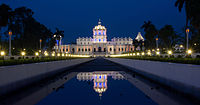
History of India (1947–present)
The history of independent India or history of Republic of India began when the country became an independent sovereign state within the British Commonwealth on 15 August 1947. Direct administration by the British, which began in 1858, affected a political and economic unification of the subcontinent. When British rule came to an end in 1947, the subcontinent was partitioned along religious lines into two separate countries—India, with a majority of Hindus, and Pakistan, with a majority of Muslims.[1] Concurrently the Muslim-majority northwest and east of British India was separated into the Dominion of Pakistan, by the Partition of India. The partition led to a population transfer of more than 10 million people between India and Pakistan and the death of about one million people. Indian National Congress leader Jawaharlal Nehru became the first Prime Minister of India, but the leader most associated with the independence struggle, Mahatma Gandhi, accepted no office. The constitution adopted in 1950 made India a democratic republic with Westminster style parliamentary system of government, both at federal and state level respectively. The democracy has been sustained since then. India's sustained democratic freedoms are unique among the world's newly independent states.[2]
This article is about the history of the Republic of India established after 1950. For the pre-establishment era of the state, see History of India.
The country has faced religious violence, naxalism, terrorism and regional separatist insurgencies. India has unresolved territorial disputes with China which escalated into a war in 1962 and 1967, and with Pakistan which resulted in wars in 1947, 1965, 1971 and 1999. India was neutral in the Cold War, and was a leader in the Non-Aligned Movement. However, it made a loose alliance with the Soviet Union from 1971, when Pakistan was allied with the United States and the People's Republic of China.
India is a nuclear-weapon state, having conducted its first nuclear test in 1974, followed by another five tests in 1998. From the 1950s to the 1980s, India followed socialist-inspired policies. The economy was influenced by extensive regulation, protectionism and public ownership, leading to pervasive corruption and slow economic growth. Since 1991, India has pursued more economic liberalisation. Today, India is the third largest and one of the fastest-growing economies in the world.
From being a relatively struggling country in its formative years,[3] the Republic of India has emerged as a fast growing G20 major economy.[4][5] India has sometimes been referred to as a great power and a potential superpower given its large and growing economy, military and population.[6][7][8][9]
2000s[edit]
Under Bharatiya Janata Party[edit]
In May 2000, India's population exceeded 1 billion. President of the United States Bill Clinton made a groundbreaking visit to India to improve ties between the two nations. In January, massive earthquakes hit Gujarat state, killing at least 30,000.
Prime Minister Vajpayee met with Pakistan's President Pervez Musharraf in the first summit between Pakistan and India in more than two years in the middle of 2001. But the meeting failed without a breakthrough or even a joint statement because of differences over Kashmir region.[110]
Three new states — Chhattisgarh, Jharkhand and Uttarakhand (originally Uttaranchal) — were formed in November 2000.
The National Democratic Alliance government's credibility was adversely affected by a number of political scandals (such as allegations that the Defence Minister George Fernandes took bribes) as well as reports of intelligence failures that led to the Kargil incursions going undetected, and the apparent failure of his talks with the Pakistani President.[110][142] Following the September 11 attacks, the United States lifted sanctions which it had imposed against India and Pakistan in 1998. The move was seen as a reward for their support for the War on Terror. The tensions of an imminent war between India and Pakistan again rose by the heavy Indian firing on Pakistani military posts along the Line of Control and the subsequent deadly Indian Parliament attack and the 2001–02 India–Pakistan standoff.[110]
In 2002, 59 Hindu pilgrims returning from Ayodhya were killed in a train fire in Godhra, Gujarat. This sparked off the 2002 Gujarat riots, leading to the deaths of 790 Muslims and 254 Hindus and with 223 people reported missing.









![Geosynchronous Satellite Launch Vehicle Mark III is intended as a launch vehicle for crewed missions under the Indian Human Spaceflight Programme announced in Prime Minister Modi's 2018 Independence Day speech.[186]](http://upload.wikimedia.org/wikipedia/commons/thumb/0/0a/GSLV_Mk_III_Lift_Off_1.jpg/260px-GSLV_Mk_III_Lift_Off_1.jpg)